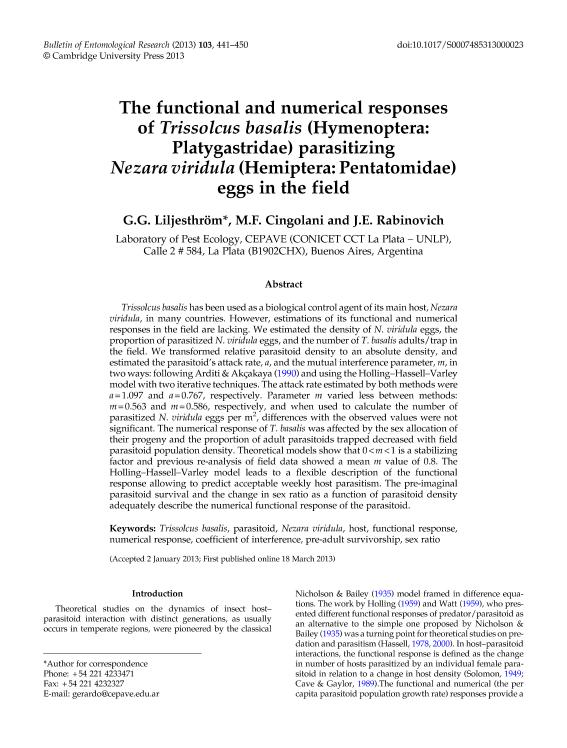Artículo
The functional and numerical responses of Trissolcus basalis (Hymenoptera: Platygastridae) parasitizing Nezara viridula (Hemiptera: Pentatomidae) eggs in the field
Fecha de publicación:
08/2012
Editorial:
Cambridge University Press
Revista:
Bulletin Of Entomological Research
ISSN:
0007-4853
e-ISSN:
1475-2670
Idioma:
Inglés
Tipo de recurso:
Artículo publicado
Clasificación temática:
Resumen
Trissolcus basalis has been used as a biological control agent of its main host, Nezara viridula, in many countries. However, estimations of its functional and numerical responses in the field are lacking. We estimated the density of N. viridula eggs, the proportion of parasitized N. viridula eggs, and the number of T. basalis adults/trap in the field. We transformed relative parasitoid density to an absolute density, and estimated the parasitoid’s attack rate, a, and the mutual interference parameter, m, in two ways: following Arditi & Akçakaya (1990) and using the Holling–Hassell–Varley model with two iterative techniques. The attack rate estimated by both methods were a= 1.097 and a= 0.767, respectively. Parameter m varied less between methods: m= 0.563 and m= 0.586, respectively, and when used to calculate the number of parasitized N. viridula eggs per m2 , differences with the observed values were not significant. The numerical response of T. basalis was affected by the sex allocation of their progeny and the proportion of adult parasitoids trapped decreased with field parasitoid population density. Theoretical models show that 0 <m< 1 is a stabilizing factor and previous re-analysis of field data showed a mean m value of 0.8. The Holling–Hassell–Varley model leads to a flexible description of the functional response allowing to predict acceptable weekly host parasitism. The pre-imaginal parasitoid survival and the change in sex ratio as a function of parasitoid density adequately describe the numerical functional response of the parasitoid.
Archivos asociados
Licencia
Identificadores
Colecciones
Articulos(CEPAVE)
Articulos de CENTRO DE EST.PARASITOL.Y DE VECTORES (I)
Articulos de CENTRO DE EST.PARASITOL.Y DE VECTORES (I)
Citación
Liljesthrom, Gerardo Gustavo; Cingolani, Maria Fernanda; Rabinovich, Jorge Eduardo; The functional and numerical responses of Trissolcus basalis (Hymenoptera: Platygastridae) parasitizing Nezara viridula (Hemiptera: Pentatomidae) eggs in the field; Cambridge University Press; Bulletin Of Entomological Research; 103; 4; 8-2012; 441–450
Compartir
Altmétricas




